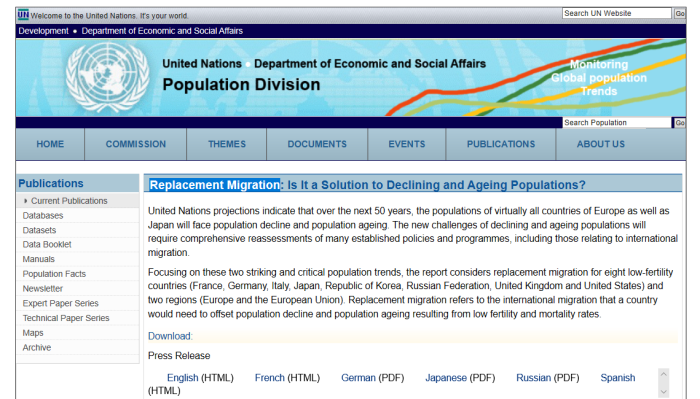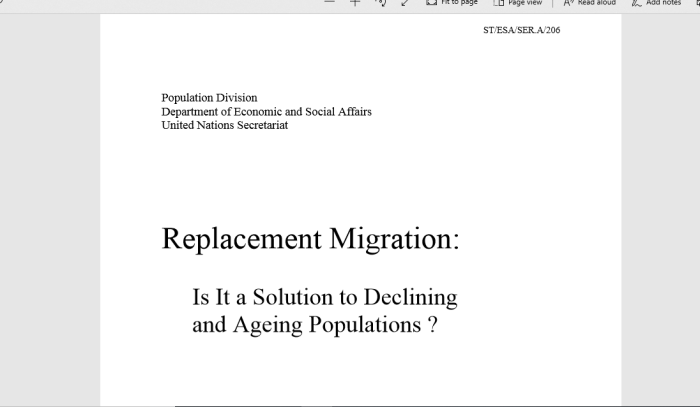





1. Important Links
U.N. Links From Article
CLICK HERE, for REPLACEMENT MIGRATION Main Page.
CLICK HERE, for the Cover and Preface.
CLICK HERE, for Overview of the Issues.
CLICK HERE, for “Conclusions and Implications”.
CLICK HERE, for UN Population Conferences (1974 Romania, 1984 Mexico, 1994 Egypt)
Other Canuck Law Articles
CLICK HERE, for tracing the steps of UN population agenda.
CLICK HERE, for replacement migration since 1974.
CLICK HERE, for multiculturalism violates convention against genocide.
CLICK HERE, for Harvard research on ethnic “fractionalization”.
CLICK HERE, for research into forced diversity.
CLICK HERE, for mass migration at 1M/year in Canada.
CLICK HERE, for migration programs in Canada.
CLICK HERE, for replacement migration since 2003/04.
CLICK HERE, for domestic violence path to permanent residence.
CLICK HERE, for International Mobility Program.
CLICK HERE, for remittances and brain drain.
CLICK HERE, for economic migration during high unemployment.
CLICK HERE, for CANZUK review.
2. Cover And Preface
The Population Division of the Department of Economic and Social Affairs at the United Nations Secretariat is responsible for providing the international community with up to-date and scientifically objective information on population and development. The Population Division provides guidance to the General Assembly of the United Nations, the Economic and Social Council and the Commission on Population and Development on population and development issues. The Division undertakes regular studies on population levels and trends, population estimates and projections, population policies and the interrelationships between population and development.
In particular, the Population Division is concerned with the following substantive areas: patterns of mortality, fertility and international and internal migration, including levels and trends, their causes and consequences, and socio-economic, geographic and gender differentials; spatial distribution of population between urban and rural areas and among cities; estimates and projections of population size, age and sex structure, spatial distribution and demographic indicators for all countries of the world; population and development policies at the national and international levels; and the relationship between socio-economic development and population change.
Does this not strike anyone as strange? A global body collecting information on population, and making recommendations about how to “correct” the issues.
There is far too much research being done for this simply to be a passing interest, or academic exercise.
Spoiler: these U.N. reports never make recommendations that a nation increase its birth rate. Nor do they think that some decline is okay. The solution is always the same — mass migration, from the 3rd World to the 1st World.
3. Overview Of The Issues
As part of its regular work programme, the United Nations Population Division continuously monitors fertility, mortality and migration trends for all countries of the world, as a basis for producing the official United Nations population estimates and projections. Among the demographic trends revealed by those figures, two are particularly salient: population decline and population ageing.
Focusing on these two striking and critical trends, the present study addresses the question of whether replacement migration is a solution to population decline and population ageing. Replacement migration refers to the international migration that would be needed to offset declines in the size of population and declines in the population of working age, as well as to offset the overall ageing of a population.
Eight countries and two regions that are treated as individual countries have been selected for this study. All of them are relatively large countries that have below-replacement fertility. The countries and regions are France, Germany, Italy, Japan, Republic of Korea, Russian Federation, the United Kingdom of Great Britain and Northern Ireland, the United States of America, Europe and the European Union. Through the technique of population projection, calculations are made of the amount of replacement migration that would be necessary for each of the eight countries and two regions to offset the expected declines in the size of the total population and working-age population, as well as to offset the overall ageing of the population.
Straight from the horse’s mouth. The goal is to study population trends and make recommendations about how much replacement migration will be needed.
The U.N. isn’t focused on higher local birth rates, or admitting that some decline isn’t that bad. Instead, the solution is always the same: REPLACEMENT MIGRATION.
4. Literature Review
in theory, two possible ways of retarding or reversing demographic ageing. First, a reversal of declines of fertility would lead the age structure of the population back towards a younger one, thus slowing down the ageing process. However, the recent experience of low-fertility countries suggests that there is no reason to assume that their fertility will return anytime soon to the above-replacement level (United Nations, 2000c; Lutz, 2000). Although Governments in those countries have introduced, instead of explicit pronatalist policies, a variety of social welfare measures favourable for higher fertility (Demeny, 2000), the long-term effectiveness of such measures is often called into question.
Hence, as a second option, the potential role that international migration could play in offsetting population decline and population ageing has been considered. International migration has become a salient global phenomena in recent years, with a growing number of countries being involved as sending or receiving countries, or both. Given the possibility of attracting larger numbers of immigrants into affluent developed economies, virtually all of which are experiencing low fertility, it appears appropriate to consider the impact that international migration may have on the demographic challenges of ageing. In formulating migration policy, it is also likely that the demand for demographic considerations will increase, as the rapid ageing process in those countries can give rise to rigidities in the labour market and social security (Organisation for Economic Cooperation and Development, 1991).
Yes, don’t even both trying to boost local birth rates. Instead, import a replacement population instead. The U.N. talks about “age” often, yet rarely mentions race, culture or ethnicity. Why? Because unique racial, ethnic, or cultural identities are not important. It is all about the numbers, and erasing those differences. It is in fact the Kalergi Plan in action
5. Conclusions And Implication
V. CONCLUSIONS AND IMPLICATIONS
The present study focuses on the question of whether replacement migration is a solution to population decline and population ageing. Replacement migration refers to the international migration that would be needed to offset declines in the size of a population, and declines in the population of working age, as well as to offset the overall ageing of a population.
The present study investigates the possible effects of international migration on the population size and age structure of a range of countries that have in common a fertility pattern below the replacement level. In the absence of migration, all countries with fertility below replacement level will see their population size start declining at some point of time in the near future, if this is not already the case today. In some countries, the projected declines in population size during the first half of the twenty-first century are as high as one quarter or one third of the entire population of the country.
Finally, the new challenges being brought about by declining and ageing populations will require objective, thorough and comprehensive reassessments of many established economic, social and political policies and programmes. Such reassessments will need to incorporate a long-term perspective. Critical issues to be addressed in those reassessments would include (a) appropriate ages for retirement; (b) levels, types and nature of retirement and health-care benefits for the elderly; (c) labour-force participation; (d) assessed amounts of contributions from workers and employers needed to support retirement and healthcare benefits for the increasing elderly population; and (e) policies and programmes relating to international migration, in particular replacement migration, and the integration of large numbers of recent migrants and their descendants. In this context, it should be noted that immigrants to one country are emigrants from another country. As such, international migration must be seen as part of the larger globalization process taking place throughout the world, influencing the economic, political and cultural character of both sending and receiving countries. While orderly international migration can provide countries of origin with remittances and facilitate the transfer of skills and technology, it also may entail the loss of needed human resources. Similarly, international migration can provide countries of destination with needed human resources and talent, but may also give rise to social tensions. Effective international migration policies must therefore take into account the impact on both the host society and countries of origin
Forcibly trying to remake a society is genocide. Despite having specific rules against it, the multicultural and mass migration policies the U.N. advocates are a form of genocide against the host nations.
Interesting how assimilation is just ONE OF the factors and not the main one. Research into forced diversity has been extensively conducted, and it has shown that multicultural and multiethnic societies are not cohesive.
The topic of remittances has been addressed before. People enter a nation, often of a “temporary” nature, as it is supposed to aid economic growth. The problem is when large amounts of workers’ take home pay is actually sent out of the country to provide for relatives. From the host country’s point of view, it actually drains money.
The conclusion talks about the cultural and political changes that take place as a result of replacement migration. While this is true, it’s not mentioned that it can frequently be a bad thing. Nothing dilutes host culture faster than having a “replacement” grow and eventually overtake it.
Also, the hypocrisy should be noted. The U.N. sees fit to implement various Carbon tax schemes, yet sees nothing wrong with importing large numbers of people from a low-consumption environment to a much higher-consumption one.
6. We Must Find Another Way
The U.N. constantly pushes mass migration and replacement migration. Why? Because it is used to forcibly change the fabric of society. In short, replacing the population means that you eventually change the nation. A country “is” its people. It is far more than just a piece of land and some laws.
Meet Viktor Orban, Hungarian Prime Minister. He introduces a policy get women to have more children. Hungary, facing a population decline of its own, has decided replacing its population is not the answer. Instead, they will try to grow organically.
“We don’t need numbers. We need Hungarian children.”
That is the kind of attitude that we need to see more of. A leader who thinks not just in terms of overall numbers, but who values a cohesive society. It is not bigotry to want to preserve your identity. However, Orban is vilified by those who seek to eliminate actual Hungarians.
